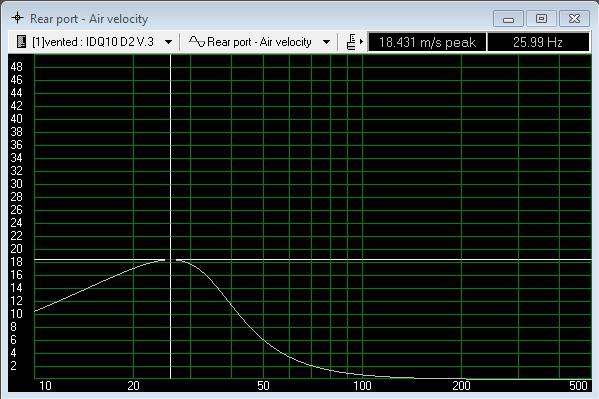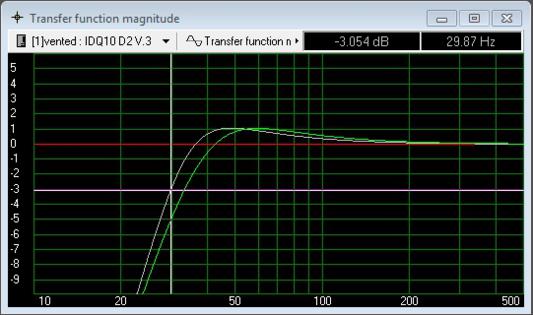Help with building a ported enclosure!
|
New member Username: The_cobblerPost Number: 1 Registered: May-11 | Hey all, I'm new to this forum and some-what new to enclosure building. I've never done a ported enclosure before so I have some questions. How do you guys calculate your port volumes? Do you just use the port calculators I find online? Or are you guys using that program WinISD? Also how forgiving is a ported enclosure when it comes to being precise about box volume, port volume, etc.? Are flared ports absolutely necessary to get good sound? |
|
Silver Member Username: AlonzoubPost Number: 135 Registered: Apr-10 | I use a mixture of WinISD Pro Alpha, some formulas from this site: http://www.carstereo.com/help/Articles.cfm, and more recently (thanks to Canaan) formulas from this site: http://www.diysubwoofers.org/ Ported enclosures are not very forgiving when looking for a specific sound. Flared ports aren't absolutely necessary, they simply allow you to use smaller port area and maintain a low noise system. If you build an enclosure that is slot-ported, having a nice large port area and a round over around the edges of the port throat will sound just as good, but will require a lot more volume then say using Precision Ports. |
|
New member Username: The_cobblerPost Number: 3 Registered: May-11 | Thanks for the reply. Ok, so how do I know what volume to use if I go with a flared port? Is there a separate calculator for that? |
|
Silver Member Username: AlonzoubPost Number: 136 Registered: Apr-10 | decide how large the port needs to be based off of the velocity of the air inside the port. Using WinISD Pro Alpha you can get a plot of vent air velocity vs frequency, like this one:  This is for my enclosure in my car. This is given a 1000 watt RMS signal, as you can see the peak air velocity is @ 26 Hz at about 18.5 m/s that is about Mach .06. For slot ported enclosures I like to keep the peak vent speed below Mach .08 (about 27 m/s) and for Flared tubes maybe Mach .13 (about 44 m/s). So since the Flared ports can handle a bit more speed without causing noise, they can have a smaller area and therefore a shorter length to maintain tuning. Thats just the rough numbers that I usually go by. Some people use Mach .05 as their maximum and some people use Mach .15. Flared ports simply slow the air down as it exits, and the main place you get port noise (chuffing) is at the exit. |
|
New member Username: The_cobblerPost Number: 4 Registered: May-11 | Ok, I looked at the links you gave me and they have been extremely helpful. The driver I'm using is a CompVR 15" Kicker and I went to the Kicker website to get all the T/S parameters for it. Something that still confuses me though is when they give me certain parameters for the volume of an enclosure (in this case 3 cu. ft - 5 cu ft.) but the equations in the links you show me would seem to give a finite volume to build for my driver. |
|
Silver Member Username: AlonzoubPost Number: 137 Registered: Apr-10 | All subwoofers come with a spec sheet or manual that lists their T/S Parameters. These are parameters such as Vas, Qes, Qms, Qts, Fs, Xmax, and Sd. These are given to you and used to design the box. You don't NEED to use the Box Volume (Vb) that the manufacturers give to you, its a recommendation. Ill show you my setup as an example again... Image Dynamics "Universal Box" recommendation for my subwoofers was 1.2 cu.ft of box volume tuned to 30 Hz. By playing with WinISD I decided to go with 1.6 cu.ft per sub for a total of 3.2 cu ft. because I wanted a heavier low-end extension, but I didn't want to make the port even longer. Here is the comparison (Green: Universal Box, Gray: My Design)  You should be careful when doing this though because WinISD is just a model. Its probably safest to chose a value within range that the manufacturer gave you and use that to calculate other aspects of the system. |
|
New member Username: The_cobblerPost Number: 5 Registered: May-11 | Right. So could I pick a certain volume that I wanted to use for my enclosure, that was within the parameters that the manufacturer gives, and then work from that volume using the equations you gave me to find other values like the port dimensions? Also, does WinISD have some sort of guide to explain how to use and how to interpret the graphs? And what is the difference between WinISD and the pro version? Sorry for the all the questions but I'm just now realizing that this is much more complex than making a sealed box. And thanks for all the help so far. |
|
Silver Member Username: AlonzoubPost Number: 138 Registered: Apr-10 | Np, I was in the same boat as you about 1 year ago, but Iv'e somewhat made it my hobby. From what I know of WinISD doesn't really have any walkthroughs but its fairly straight forward. I prefer WinISD Pro Alpha because it has vent velocity plots, impedance plots, and cone excursion plots that normal WinISD doesn't have. It is alpha stage software though, so all of its features aren't 100% functional yet and it gives me errors when I try to close it, I have to kill the process in my task manager to get it to close. |
|
New member Username: The_cobblerPost Number: 7 Registered: May-11 | I've been using WinISD for a few days now and I think i'm beginning to get the hang of it. One lingering question I have is when I get dimensions for my port opening (i'm using a square), does the port have to be constructed using one of the existing walls of the entire enclosure or can the port be placed anywhere as long as it has the right dimensions and is not too close to the driver? |
Main Forums
Today's Posts- Home Audio Forum
- Home Video Forum
- Home Theater Forum
- Car Audio Forum
- Accessories Forum
- All Forum Topics